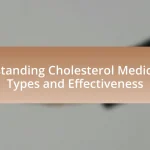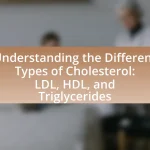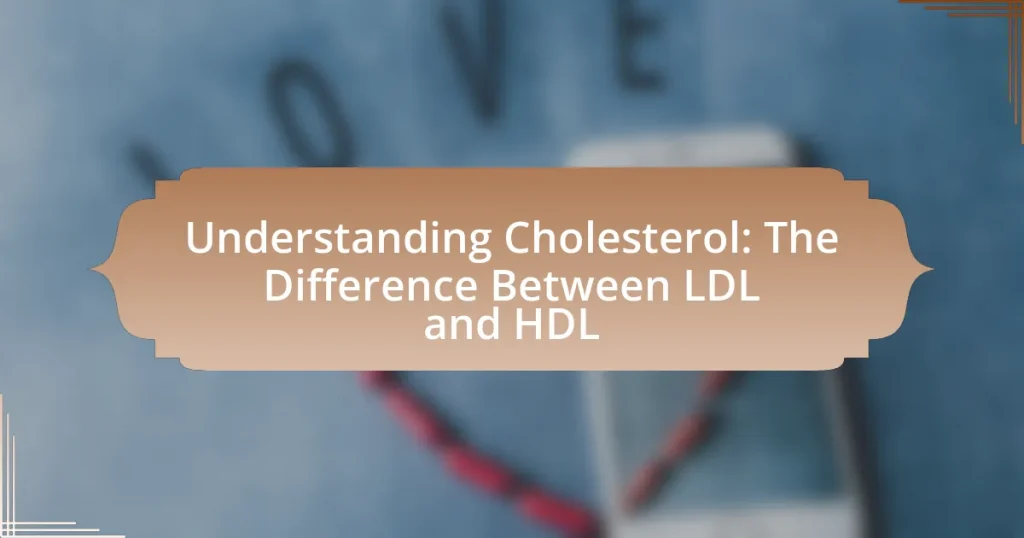Cholesterol is a waxy, fat-like substance essential for various bodily functions, including hormone production and digestion. This article explores the two main types of cholesterol: low-density lipoprotein (LDL), often termed “bad” cholesterol due to its association with heart disease, and high-density lipoprotein (HDL), known as “good” cholesterol for its protective role in cardiovascular health. It discusses the significance of maintaining a healthy balance between LDL and HDL levels, the impact of diet and exercise on cholesterol management, and available medical treatments for high cholesterol. Understanding these aspects is crucial for reducing the risk of cardiovascular diseases and promoting overall health.

What is Cholesterol and Why is it Important?
Cholesterol is a waxy, fat-like substance found in every cell of the body, essential for producing hormones, vitamin D, and bile acids that help digest fat. It is important because it plays a critical role in maintaining cell membrane structure and function, as well as supporting the synthesis of vital substances necessary for overall health. The body produces cholesterol naturally, but it can also be obtained from dietary sources. High-density lipoprotein (HDL) cholesterol is known as “good” cholesterol because it helps remove other forms of cholesterol from the bloodstream, while low-density lipoprotein (LDL) cholesterol is referred to as “bad” cholesterol due to its association with an increased risk of heart disease when levels are elevated.
What are the different types of cholesterol?
The different types of cholesterol are Low-Density Lipoprotein (LDL) and High-Density Lipoprotein (HDL). LDL is often referred to as “bad” cholesterol because high levels can lead to plaque buildup in arteries, increasing the risk of heart disease. In contrast, HDL is known as “good” cholesterol as it helps remove other forms of cholesterol from the bloodstream, thereby reducing the risk of cardiovascular issues. According to the American Heart Association, maintaining a healthy balance between these two types is crucial for cardiovascular health.
What is LDL cholesterol and what role does it play in the body?
LDL cholesterol, or low-density lipoprotein cholesterol, is a type of cholesterol that carries fats and cholesterol through the bloodstream. It plays a crucial role in the body by delivering cholesterol to cells, which is essential for producing hormones, vitamin D, and substances that help digest foods. However, high levels of LDL cholesterol can lead to plaque buildup in arteries, increasing the risk of cardiovascular diseases such as heart attacks and strokes. Studies indicate that maintaining healthy LDL levels is vital for cardiovascular health, with optimal levels generally considered to be below 100 mg/dL.
What is HDL cholesterol and how does it function?
HDL cholesterol, or high-density lipoprotein cholesterol, is a type of cholesterol that is often referred to as “good” cholesterol due to its role in transporting cholesterol away from the arteries and back to the liver for excretion or recycling. This function helps reduce the risk of cardiovascular diseases by preventing the buildup of plaque in the arteries. Studies indicate that higher levels of HDL cholesterol are associated with a lower risk of heart disease, as it aids in the removal of excess cholesterol from the bloodstream, thus promoting overall heart health.
How does cholesterol affect overall health?
Cholesterol significantly affects overall health by influencing the risk of cardiovascular diseases. High levels of low-density lipoprotein (LDL) cholesterol, often referred to as “bad” cholesterol, can lead to the buildup of plaques in arteries, increasing the likelihood of heart attacks and strokes. Conversely, high levels of high-density lipoprotein (HDL) cholesterol, known as “good” cholesterol, help remove LDL cholesterol from the bloodstream, thereby reducing cardiovascular risk. According to the American Heart Association, maintaining a healthy balance between LDL and HDL cholesterol is crucial for heart health, with optimal LDL levels being below 100 mg/dL and HDL levels ideally above 60 mg/dL.
What are the risks associated with high LDL cholesterol levels?
High LDL cholesterol levels significantly increase the risk of cardiovascular diseases, including heart attacks and strokes. Elevated LDL cholesterol contributes to the buildup of plaque in arteries, leading to atherosclerosis, which narrows blood vessels and restricts blood flow. According to the American Heart Association, individuals with high LDL cholesterol are at a greater risk, with studies indicating that for every 1% increase in LDL cholesterol, the risk of heart disease can increase by 1-2%. This correlation underscores the importance of managing LDL levels to reduce the likelihood of serious health complications.
How does HDL cholesterol contribute to heart health?
HDL cholesterol contributes to heart health by transporting excess cholesterol from the arteries back to the liver for excretion, thereby reducing the risk of atherosclerosis. This process helps prevent the buildup of plaque in the arteries, which can lead to heart disease and stroke. Studies have shown that higher levels of HDL cholesterol are associated with a lower risk of cardiovascular events, as HDL also possesses anti-inflammatory and antioxidant properties that further protect the cardiovascular system.

What are the Key Differences Between LDL and HDL?
LDL (Low-Density Lipoprotein) and HDL (High-Density Lipoprotein) are two types of cholesterol that differ primarily in their function and impact on cardiovascular health. LDL is often referred to as “bad” cholesterol because it can lead to the buildup of plaque in arteries, increasing the risk of heart disease and stroke. In contrast, HDL is known as “good” cholesterol as it helps remove other forms of cholesterol from the bloodstream, transporting it to the liver for excretion or recycling, thereby reducing the risk of cardiovascular issues. Studies indicate that high levels of LDL are associated with a greater risk of heart disease, while higher levels of HDL are linked to a lower risk, emphasizing the importance of maintaining a healthy balance between these two types of cholesterol.
How do LDL and HDL cholesterol differ in structure and function?
LDL (low-density lipoprotein) and HDL (high-density lipoprotein) cholesterol differ significantly in both structure and function. LDL is composed of a higher proportion of lipids to proteins, making it less dense, while HDL contains more proteins relative to lipids, resulting in a denser structure. Functionally, LDL is primarily responsible for transporting cholesterol from the liver to peripheral tissues, which can lead to plaque buildup in arteries if levels are elevated. In contrast, HDL functions to transport cholesterol away from tissues back to the liver for excretion or recycling, thus playing a protective role against cardiovascular disease. This distinction in structure and function underscores the importance of maintaining balanced levels of both types of cholesterol for cardiovascular health.
What is the significance of the density of LDL and HDL?
The density of LDL (low-density lipoprotein) and HDL (high-density lipoprotein) is significant because it influences their roles in cardiovascular health. LDL, being less dense, is associated with the transport of cholesterol to tissues, which can lead to plaque buildup in arteries, increasing the risk of heart disease. In contrast, HDL, with its higher density, is involved in reverse cholesterol transport, helping to remove cholesterol from the bloodstream and transport it to the liver for excretion, thereby reducing cardiovascular risk. Studies have shown that higher levels of HDL are linked to lower rates of heart disease, while elevated LDL levels are a strong predictor of atherosclerosis and related conditions.
How do LDL and HDL interact with other lipids in the body?
LDL (low-density lipoprotein) and HDL (high-density lipoprotein) interact with other lipids in the body primarily through their roles in lipid transport and metabolism. LDL carries cholesterol and triglycerides from the liver to peripheral tissues, facilitating the delivery of essential lipids for cellular functions. In contrast, HDL is responsible for reverse cholesterol transport, collecting excess cholesterol from tissues and transporting it back to the liver for excretion or recycling. This interplay helps maintain lipid homeostasis and influences overall cardiovascular health. Studies have shown that elevated LDL levels are associated with increased risk of atherosclerosis, while higher HDL levels are linked to protective cardiovascular effects, underscoring the importance of their interaction with other lipids in regulating lipid profiles and preventing disease.
Why are LDL and HDL levels measured in blood tests?
LDL and HDL levels are measured in blood tests to assess cardiovascular health and the risk of heart disease. LDL, or low-density lipoprotein, is often referred to as “bad” cholesterol because high levels can lead to plaque buildup in arteries, increasing the risk of atherosclerosis and heart attacks. Conversely, HDL, or high-density lipoprotein, is known as “good” cholesterol as it helps remove LDL from the bloodstream, thereby reducing cardiovascular risk. Monitoring these levels allows healthcare providers to evaluate an individual’s lipid profile and make informed decisions regarding lifestyle changes or treatments to mitigate heart disease risk.
What do the results of LDL and HDL tests indicate about health?
LDL (low-density lipoprotein) and HDL (high-density lipoprotein) test results indicate cardiovascular health. High levels of LDL cholesterol are associated with an increased risk of heart disease and stroke, as LDL can lead to plaque buildup in arteries. Conversely, high levels of HDL cholesterol are linked to a lower risk of heart disease because HDL helps remove cholesterol from the bloodstream and transport it to the liver for excretion. According to the American Heart Association, optimal LDL levels are below 100 mg/dL, while HDL levels should be 60 mg/dL or higher for protective effects against heart disease.
How can one interpret their cholesterol test results effectively?
To interpret cholesterol test results effectively, one should focus on the levels of LDL (low-density lipoprotein), HDL (high-density lipoprotein), and total cholesterol. LDL is often referred to as “bad” cholesterol, as high levels can lead to plaque buildup in arteries, increasing heart disease risk. Conversely, HDL is known as “good” cholesterol because it helps remove LDL from the bloodstream. A desirable LDL level is typically below 100 mg/dL, while an HDL level of 60 mg/dL or higher is considered protective against heart disease. Total cholesterol should ideally be below 200 mg/dL. Understanding these values allows individuals to assess their cardiovascular health and make informed lifestyle choices.

How Can One Manage Cholesterol Levels Effectively?
To manage cholesterol levels effectively, individuals should adopt a heart-healthy lifestyle that includes a balanced diet, regular physical activity, and weight management. A diet low in saturated fats and trans fats, while rich in fruits, vegetables, whole grains, and healthy fats, can significantly lower LDL cholesterol levels. According to the American Heart Association, consuming foods high in omega-3 fatty acids, such as fatty fish, can also improve overall cholesterol profiles. Regular exercise, such as 150 minutes of moderate aerobic activity per week, can raise HDL cholesterol and lower LDL cholesterol. Additionally, maintaining a healthy weight can further contribute to better cholesterol management, as losing even a small amount of weight can positively impact cholesterol levels.
What lifestyle changes can help improve cholesterol levels?
To improve cholesterol levels, individuals should adopt a heart-healthy lifestyle that includes regular physical activity, a balanced diet low in saturated fats and trans fats, and maintaining a healthy weight. Engaging in at least 150 minutes of moderate aerobic exercise weekly can raise HDL (good cholesterol) levels and lower LDL (bad cholesterol) levels. A diet rich in fruits, vegetables, whole grains, and healthy fats, such as those found in olive oil and avocados, can significantly reduce LDL cholesterol. Additionally, losing just 5-10% of body weight can lead to improvements in cholesterol levels, as supported by research from the American Heart Association, which indicates that lifestyle modifications can lead to a 10-20% reduction in LDL cholesterol.
How does diet influence LDL and HDL cholesterol levels?
Diet significantly influences LDL (low-density lipoprotein) and HDL (high-density lipoprotein) cholesterol levels. Consuming saturated fats and trans fats raises LDL cholesterol, while a diet rich in unsaturated fats, such as those found in olive oil, nuts, and fatty fish, can increase HDL cholesterol levels. Research published in the Journal of the American College of Cardiology indicates that replacing saturated fats with unsaturated fats can lower LDL cholesterol by 5-10%. Additionally, dietary fiber, particularly soluble fiber found in oats and legumes, can further reduce LDL levels by binding cholesterol in the digestive system. Thus, dietary choices play a crucial role in managing cholesterol levels effectively.
What role does exercise play in managing cholesterol levels?
Exercise plays a crucial role in managing cholesterol levels by increasing high-density lipoprotein (HDL) cholesterol and lowering low-density lipoprotein (LDL) cholesterol. Regular physical activity, such as aerobic exercise, has been shown to improve lipid profiles; studies indicate that engaging in at least 150 minutes of moderate-intensity exercise per week can raise HDL levels by 5% to 10% and lower LDL levels significantly. This effect is attributed to exercise’s ability to enhance the body’s metabolism and promote the clearance of LDL cholesterol from the bloodstream.
What medical treatments are available for cholesterol management?
Medical treatments available for cholesterol management primarily include statins, bile acid sequestrants, cholesterol absorption inhibitors, and PCSK9 inhibitors. Statins, such as atorvastatin and simvastatin, are the most commonly prescribed medications and have been shown to reduce LDL cholesterol levels by 20-60%. Bile acid sequestrants, like cholestyramine, work by binding bile acids in the intestine, leading to decreased cholesterol absorption. Cholesterol absorption inhibitors, such as ezetimibe, specifically target the absorption of cholesterol from the diet. PCSK9 inhibitors, including alirocumab and evolocumab, are newer agents that significantly lower LDL cholesterol levels by enhancing the liver’s ability to remove LDL from the bloodstream. These treatments are supported by clinical guidelines and studies demonstrating their efficacy in reducing cardiovascular risk associated with high cholesterol levels.
What are the common medications prescribed for high cholesterol?
Common medications prescribed for high cholesterol include statins, bile acid sequestrants, niacin, and fibrates. Statins, such as atorvastatin and simvastatin, are the most frequently used due to their effectiveness in lowering LDL cholesterol levels. Bile acid sequestrants, like cholestyramine, work by binding bile acids in the intestine, which helps reduce cholesterol absorption. Niacin, also known as vitamin B3, can improve HDL cholesterol levels, while fibrates, such as fenofibrate, primarily lower triglyceride levels. These medications are supported by clinical guidelines and studies demonstrating their efficacy in managing cholesterol levels and reducing cardiovascular risk.
How do these medications work to lower LDL and raise HDL?
Medications that lower LDL (low-density lipoprotein) and raise HDL (high-density lipoprotein) primarily function through mechanisms such as inhibiting cholesterol synthesis, enhancing cholesterol uptake, and promoting reverse cholesterol transport. Statins, for example, inhibit the enzyme HMG-CoA reductase, which decreases cholesterol production in the liver, leading to lower LDL levels. Additionally, medications like niacin can increase HDL levels by reducing the breakdown of apolipoprotein A-I, a key component of HDL. Clinical studies have shown that statins can reduce LDL cholesterol by 20-60%, while niacin can raise HDL cholesterol by 15-35%, demonstrating their effectiveness in managing cholesterol levels.
What are some practical tips for maintaining healthy cholesterol levels?
To maintain healthy cholesterol levels, individuals should focus on a balanced diet, regular physical activity, and avoiding tobacco smoke. A diet rich in fruits, vegetables, whole grains, and healthy fats, such as those found in olive oil and avocados, can help lower LDL cholesterol. Regular exercise, such as 150 minutes of moderate aerobic activity per week, can improve HDL cholesterol levels. Additionally, avoiding tobacco smoke can significantly reduce the risk of heart disease and improve overall cholesterol levels. Studies indicate that these lifestyle changes can lead to a 5-10% reduction in LDL cholesterol levels, contributing to better cardiovascular health.










